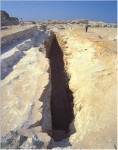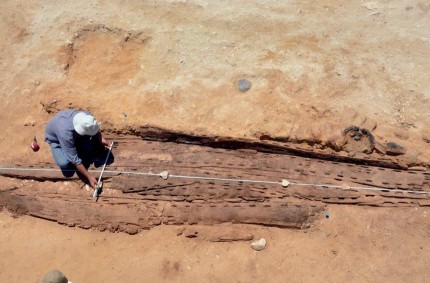 A team from the French Institute of Oriental Archaeology excavating the ancient site of Abu Rawash 15 miles northwest of Cairo has unearthed the remains of a solar boat dating to the reign of the First Dynasty pharaoh Den (ca. 2975–2935 B.C.). The boat is nearly intact, composed of 11 planks of local wood 20 feet long and five feet wide. The wood is in good condition, thanks to the preservation power of the dry desert environment.
A team from the French Institute of Oriental Archaeology excavating the ancient site of Abu Rawash 15 miles northwest of Cairo has unearthed the remains of a solar boat dating to the reign of the First Dynasty pharaoh Den (ca. 2975–2935 B.C.). The boat is nearly intact, composed of 11 planks of local wood 20 feet long and five feet wide. The wood is in good condition, thanks to the preservation power of the dry desert environment.
Pharaoh Den was not actually buried at Abu Rawash. His tomb is in the royal necropolis of Early Dynastic kings at Abydos in Upper Egypt. His seal has been discovered at Abu Rawash, however, which may be how archaeologists were able to date the solar boat to his reign. Abu Rawash is best known as the site of the ruined pyramid of the pharaoh Djedefre, son of and successor to Khufu, builder of the great pyramid at Giza. Djedefre was a king of the Fourth Dynasty who reigned from about 2566 to 2558 B.C., 400 years after Den.
 His pyramid complex at Abu Rawash actually includes a solar boat pit, a ditch 115 feet long cut out of the living limestone next to the pyramid, which was intended to hold his solar boat. No boat was found within. Instead, archaeologists recovered thousands of fragments of statues from the pit, which when put together turned out to be sculpted heads of Djedefre, now in the Louvre.
His pyramid complex at Abu Rawash actually includes a solar boat pit, a ditch 115 feet long cut out of the living limestone next to the pyramid, which was intended to hold his solar boat. No boat was found within. Instead, archaeologists recovered thousands of fragments of statues from the pit, which when put together turned out to be sculpted heads of Djedefre, now in the Louvre.
Although none of the articles I’ve found explicitly state this, I think the boat was probably found in the protodynastic cemetery on a rocky outcropping above the Abu Rawash pyramid site. Called “M” after archaeologist Pierre Montet who first discovered it in 1913, the necropolis contains 25 mid-First Dynasty tombs made out of mud bricks. These tombs belonged to elite members of early Old Kingdom society and have been a rich source of information about the development of monumental pharaonic funerary architecture, artifacts and practices in Lower Egypt. Finding a virtually intact solar boat is therefore extremely significant.
 Solar boats were ritual vessels that were buried near kings to carry their souls to the heavens where their father, the sun god Ra, awaited them. Ra traveled on two boats during the course of his daily duties, the morning boat that carried him across the heavens during the day, and the evening boat that carried him through the underworld at night. There is some debate among Egyptologists as to whether the solar boats were used to carry the pharaoh’s body over water during the funerary procession or whether they were made just to be buried for the pharaoh’s posthumous use. The most glamorous of solar ships, Pharaoh Khufu’s 140-feet-long and 20-feet-wide cedar yacht discovered in a pit at the foot of the Great Pyramid of Giza in 1954, shows some signs of having been in contact with water, but cedar shavings found in the pit suggest that it was built on site.
Solar boats were ritual vessels that were buried near kings to carry their souls to the heavens where their father, the sun god Ra, awaited them. Ra traveled on two boats during the course of his daily duties, the morning boat that carried him across the heavens during the day, and the evening boat that carried him through the underworld at night. There is some debate among Egyptologists as to whether the solar boats were used to carry the pharaoh’s body over water during the funerary procession or whether they were made just to be buried for the pharaoh’s posthumous use. The most glamorous of solar ships, Pharaoh Khufu’s 140-feet-long and 20-feet-wide cedar yacht discovered in a pit at the foot of the Great Pyramid of Giza in 1954, shows some signs of having been in contact with water, but cedar shavings found in the pit suggest that it was built on site.
The Abu Rawash boat has been removed to the Egyptian Museum in Cairo for conservation. Once it’s in stable condition, it will go on display at the National Museum for Egyptian Civilization which is still under construction. The solar boat is expected to be ready for public display sometime next year.
